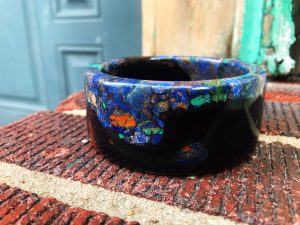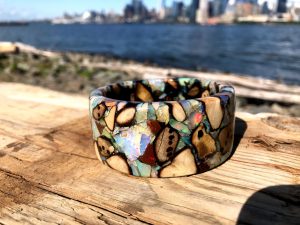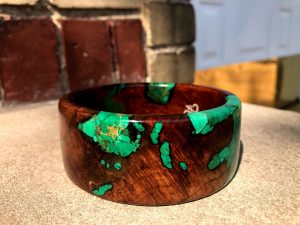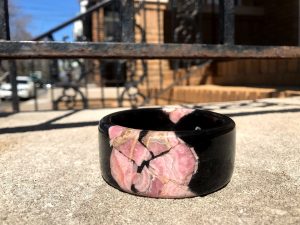Freestone Peach: Refurbished Masterpieces
Working with what he had, Joel Baynard brought “unwanted” organic materials together to create one-of-a-kind jewelry. Inspired by Shibui culture, Baynard finds beauty in the everyday process, which allows him to cultivate wood and gemstones scraps into magnificent pieces. Read more about his woodworking journey below.
Besides Shibui having a huge influence on your work, can you explain how else it has impacted your life?
I recall reading that a shibui object did not begin as an idea for a masterpiece. The beauty comes from the process in making the everyday object. Like that, life is an everyday process. I think that it’s making the best you can with the parameters of material and time allotted to you. It’s a continuous work in progress to accept that, and I feel more inclined to flow with it every day.

STAINED BLACK WALNUT AND AZURITE MINERAL BANGLE, BY FREESTONE PEACH
In fact, my business analytics professor told me what makes life beautiful is that it is one part random and one part deterministic. In other words, I may not be able to control what happens, but I can control my response to it.
In 2013, you began selling your own unique jewelry. Has there been any implication before that, where you may have envisioned yourself designing such pieces?
Never! My formal degree is in Civil Engineering. I enjoyed managing construction and repair projects for hospitals. In 2012, I was a student in a MBA program where I was focused on strategic planning and marketing for healthcare. During that time I was an administrative intern in Neurosciences.
Alas, my GPA was 2.845, and I needed a 3.000. So, the university asked me to leave the program. At that point, I started teaching myself how to turn wood on the lathe in my dad’s shop.
Beyond Shibui, can you elaborate on your other sources of inspiration?
Shibui goes hand in hand with my upbringing, in my opinion. My family is from the foothills of the Southern Appalachians. For a long time there it was about survival, working with the materials you have, and making them go as far they can.
As for other visual influences, I’m receptive to anything; formal and otherwise: Impressionism and Fauvism. Arts and Craft era design (furniture of Gustav Stickley). I’m also a huge fan of the colorful and the Brazilian fashions in my neighborhood. Spending time next to any body of water. The play of light and reflecting the atmosphere above. Walking around the woods. The city and the weathered textures of the infrastructure.

HOLLY WOOD AND ETHIOPIAN OPAL BANGLE, BY FREESTONE PEACH
Having lived in Japan and incorporating the culture in your work, do you find it important to visit every so often? When was your last trip? Have you created any pieces that contain materials exclusively from Japan?
I haven’t been to Japan in a long time. I would like to go back one day. Maybe even set up a shop for a short stint. Also, I’d love to find a retailer there who would work with me.
I’ve never used materials from Japan. However, the Japanese clients that I have seemed to prefer to order cherry wood. The Japanese have a strong affinity for cherry blossoms. And honestly the best feeling is that I have my bangles actually in Japan. The best analog that I could offer for this situation is Frank Lloyd Wright. His work was heavily influenced by Japan, and his work is treasured there.
Are most of your materials locally sourced? How do you select which unwanted and damaged pieces to refurbish and make new?
The wood is from around Southwest North Carolina and the Upstate of South Carolina. I still do the woodwork there. But if I see something interesting around here, I’ll load it in the truck.
Have you ever made an expedition specifically to hand-collect unwanted or damaged pieces? Is there a place you would love to source from directly?
I started by retrieving discarded wood from orchards. I would also dig up stumps and dead trees in peach orchards. Apple orchard owners push up non-producing trees. These days, I have a few arborists that I work with. They know what I’m looking for.

WORMY CHERRY BURL AND MALACHITE MINERAL BANGLE, BY FREESTONE PEACH
“Imperfection” is one of the qualities of Shibui; can you discuss how you decide when one of your designs is finished?
I stop when I don’t see how filling one more gap will add any aesthetic value. I also prefer to leave the finish short of super glossy, but finer than satin. I feel there’s something warmly inviting about the fine lines. They catch the light without the glare, and give the piece a touchable appearance.
What made you think to bring two “unwanted” organic materials together? Has it always been a combination of gemstones and wood?
I was shopping for jewelry for a love interest at the time. I was looking around one store, and noticed the wooden bangles. I thought they were just plain, without any character.
I grew up around woodwork, and I knew that wood could have a more interesting figure than what I saw. So, I started going through my grandfather’s wood scrap, and began teaching myself how to turn a bangle on the lathe. Then one day, my dad says to me, “The way you’ve set that piece [on the lathe] you’re going to have a big hole.” So, I decided to plug that spot with stone. I didn’t have cash to spare to buy crushed inlay material. So, I went to the garage, and found my collection of rocks that I kept since childhood. I took out some emeralds and quartz, smashed them with a hammer, and then filled the hole.
My process flew from there. That was February 2013. I sold my first piece to a lady at local bead store in May 2013. The owner of that store told me I needed to contact a store near Orlando, Florida. There I made my first retail sale in August 2013. And from there, I was emboldened to keep making.
How have you adapted to COVID-19? Has it had any effect on your work?
I haven’t felt a massive impact from COVID-19. I still have the raw materials for my main work. I was starting to work with metals for new designs, and that has been paused.

EBONIZED BLACK WALNUT AND RHODOCHROSITE BANGLE, BY FREESTONE PEACH
Shibui has been an influence in your work, as we discussed before. One quality of Shibui is “silence.” Can you elaborate on how that is reflected in your creations?
Silence is rest, a resolution of energy. Without silence, the bright hues in the stones would cause the eyes to become fatigued. So I use both imperfections within them, and the texture of the wood, to balance the bursts of color.
After a fantastic display of color, the subtle figures bring some rest to your eyes. And vice versa, after a lull of soft earth tones, the pops in color invigorate the palate. This allows one to look at a piece virtually in perpetuity.
Tell us about your favorite wood and gemstone combination, is there one you feel that represents who you are? Or someone of significance to you?
The red-orange woods, like peach, cherry, or plum (they’re all in the prune family) remind me of the red clay and agriculture roots from my place of birth. Black walnut always reminds me of how my grandfather’s shop smelled. So, that’s tough to choose.
But for colors, I’ll say peach with azurite. It’s been my profile picture for 7 years. I also like to add turquoise and malachite to that. That’s my true color biography. And it looks a lot like all the colors that I would see outdoors in Southwest North Carolina– red clay, green trees, blue skies and waters (but I’m getting pretty happy when I blend the pink rhodochrosite with black walnut these days).
Let’s talk about bangles. Your Instagram displays several different creations of vast gemstone and wood combinations, yet is dominated by bangles. Why are bangles your most superior product?
Bangles are what people keep ordering. I think it’s the visual landscape of them that keeps them revolving. They grab your eye, and they keep your attention because each angle offers a different perspective of color and figure. If you could flatten one out, it would be about 8” long by 1.25” wide. That’s a vast terrain of wood and stone for the scale. Rotating it can hold one’s attention for hours.
Joel Baynard expresses his talent and creativity through the creation of his beautiful, one-of-a-kind pieces, made solely out of organic material scraps. To see more of Joel Baynard’s unique jewelry, find Freestone Peach on Instagram @freestonepeach or email Joel directly at freestonepeachdesigns@gmail.com.